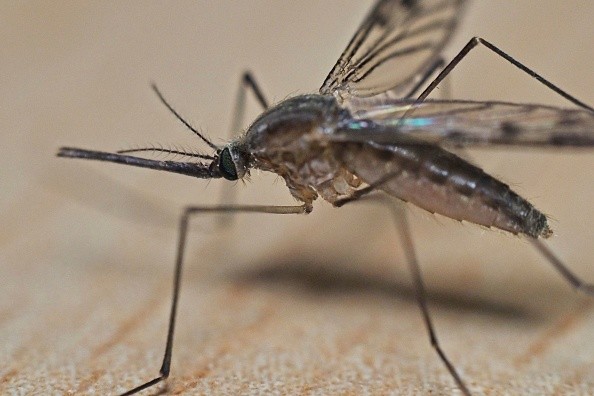Researchers are developing a more effective method of tracking mosquitos for disease applications.
Their new method, which involves feeding harmless particles made entirely of DNA and proteins to larval mosquitos, has the potential to change the way people study mosquito-borne diseases.
Tracking disease-carrying mosquitoes
 (Photo : GUILLAUME SOUVANT/AFP via Getty Images)
(Photo : GUILLAUME SOUVANT/AFP via Getty Images)

West Nile, Zika, dengue, and malaria are all diseases spread by mosquito bites. Scientists need to know where the mosquitoes are, where they've been, and where they might go in order to track the threat of such diseases across large populations.
But, as Rebekah Kading, a Colorado State University researcher who studies mosquito-borne arboviruses, can attest, tracking mosquitos is a difficult task.
Capturing, tagging, and releasing a single mosquito, as is done with bats and other disease carriers, would be absurd, if not impossible.
Dousing the insects in fluorescent powder and letting them fly away is a common mosquito-tracking technique, but it is error-prone and unreliable.
Kading and colleagues are introducing a better way to perform mosquito-tracking for disease applications thanks to a collaboration with CSU engineers.
Their new method, which involves feeding harmless particles made entirely of DNA and proteins to larval mosquitos, has the potential to change the way people study mosquito-borne diseases.
Chris Snow, an associate professor in the Department of Chemical and Biological Engineering, created the edible mosquito marker particles.
Snow's team has been working on microscopic, porous protein crystals that self-assemble from a protein originally discovered in Camplyobacter jejuni bacteria for several years.
Snow's team has been exploring various applications for these very small, non-toxic protein crystals with highly precise arrays of pores since inventing them, such as capturing virus particles to facilitate wastewater testing.
Years ago, they discovered that they could easily insert fluorescent dyes or synthetic DNA into their crystals, and the DNA would not budge even after multiple washes and solvent exposure.
"We discovered a material that holds onto nucleic acids very, very tightly by pure chance," Snow explained.
He began to believe that these DNA snippets could act as "barcodes" inside the porous crystals, providing unique information fingerprints.
When Kading, an associate professor in the Department of Microbiology, Immunology, and Pathology, heard about Snow's work, he wondered if these tiny engineered crystal barcodes could be used in a mosquito-tagging application.
Read more: Mosquito Swarm Strikes Farmer's Home After Heavy Rainfall Events in Australia [Video]
Mosquito larvae eat barcodes
Mosquito larvae eat delicious biomass that has been pre-loaded with DNA crystals in solution. As the mosquitos mature, the DNA crystals in their guts remain intact, forming a code that can later be read using laboratory techniques such as quantitative polymerase chain reaction.
The details are described in a recent paper published in PNAS Nexus by the researchers.
The mosquito-marking crystals were tested in small pilot plots in east Fort Collins during the summers of 2020 and 2021.
Kading's team repeated the experiments in other parts of the city the following summer and is now analyzing the results.
The method demonstrated by the researchers is distinct in one important way: unlike traditional mosquito tagging, in which adult mosquitos are collected from traps and tested for disease, the DNA barcodes are ingested by mosquito larvae and remain with them as adults.
Researchers can thus track not only where mosquitos ended up, but also where they started and how they moved.
Such comprehension, according to Kadding, could be critical for future disease surveillance applications.
Because they only use synthetic DNA fragments, researchers can include thousands of barcodes in each batch of mosquitoes, resulting in thousands of unique signatures.
Coding wants to test the temporal component of tagging: mosquito larvae ingest different barcodes each week, allowing researchers to determine not only where the mosquitoes began and ended, but also when they ate which barcodes.
She also wants to expand her research in tropical areas where mosquito-borne diseases are a daily threat.
The use of protein crystals to label DNA mosquitos has great potential, but the team, like any good scientist, still has many questions to answer.
For starters, they don't know why the DNA fragments are so well preserved in the mosquito's gut.
They also want to know how long the barcodes last in the mosquito's gut and if there are any ways to improve performance, such as making the crystals stickier.
Finally, scalability is an important consideration. Although the technology works in the lab, what about commercial applications?
Kadding, Snow, and their teams are excited to work together to find the answers. "It was a fantastic interdisciplinary collaboration," said Kadding.
Related article: Techniques on Dealing With Wildfires May Help Mosquito Problem
© 2024 NatureWorldNews.com All rights reserved. Do not reproduce without permission.

![Tsunami Hazard Zones: New US Map Shows Places at Risk of Flooding and Tsunamis Amid Rising Sea Levels [NOAA]](https://1471793142.rsc.cdn77.org/data/thumbs/full/70325/280/157/50/40/tsunami-hazard-zones-new-us-map-shows-places-at-risk-of-flooding-and-tsunamis-amid-rising-sea-levels-noaa.jpg)



